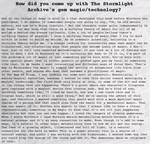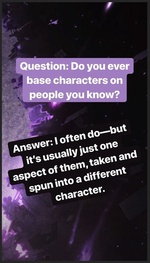Questioner
I think you're going to get asked a lot about the Cosmere today, so I wanted to make a question about the Reckoners saga, because, while I was reading it, there was one recurring thought in my mind, and it was, "Gosh, I wish I could have read this as a teenager," and it's equally enjoyable as a adult, but that kept running in my mind, and I was wondering if when you wrote it, you wrote it with these audiences in mind, or it's simply that David is so real and so like us when we were fifteen or fourteen that it came out that way?
Brandon Sanderson
I'm very curious that you noticed this, because in the United States, this is actually published as a young adult novel. In the UK and Spain, and France, it is published as an adult novel. And I very much left it up to my publishers to decide what was best for their market, because David is nineteen, which puts it on the border between is this a young adult or an adult novel. However, when I was writing it, my target reader in my head was me at age fourteen, because, when I was young, it wasn't that nobody gave me books--people did give me books, they tried to make me into a reader--but the books were all boring, and I think the great power of science fiction and fantasy is that we are able to mix deep thought and exciting narrative. Every morning, my wife makes a smoothie for my children with ice cream. They love ice cream, my three little boys, so they're very excited, and every morning she adds a handful of spinach to it, because they love the color green and they think it's cool to drink a green drink. Of course, she adds it because the spinach is very healthy, and I feel like science fiction and fantasy is very good at this blend for books. All of our books are green, because we deal with very important issues, but we mix them with wonder, exploration, adventure, and human experience.
The Reckoners is about power corrupting. I started the first book after driving on the road and nearly getting in a car wreck because someone pulled in front of me too quickly, and I was very annoyed with this person, and in that moment I imagined myself blowing the car up. I thought, "You are so lucky I don't have superpowers." It was a very cool explosion, too. Yeah, I have a good imagination. After this, I was immediately horrified, because I write books about people, generally, who get incredible powers, and then go on to protect others, but in that moment, I had the worry that I could not be trusted, myself, with those powers. So, The Reckoners is about what happens if people start gaining superpowers, but only evil people get them. It's Marvel's universe with no Avengers.


